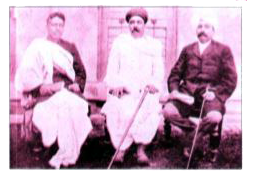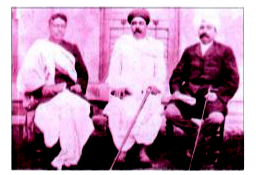The conflict between the two sections of the Congress came to surface in its Session in 1906 at Calcutta. In this context explain the following:
State any four methods that they advocated for the achievement of their aims.
Four methods advocated by the Assertive Nationalists for the achievement of their aims are:
(i) Swadeshi : It means producing necessary items in one.s own country and using them for one.s use without being dependent on imported goods. This idea was popularized by occasional bonfires of foreign cloth, salt and sugar.
(ii) Boycott: Swadeshi and boycott are the two sides of the same coin. Tilak said, "When you accept Swadeshi, you must boycott foreign goods". Economic boycott of British goods and use of Swadeshi was designed to encourage Indian industries and provide the people with more opportunities for employment
(iii) National education : A National scheme of education was planned which was to replace Government controlled universities and colleges. The Assertive Nationalists tried to enlist the students in their service. When the British government threatened to take disciplinary action against the students, the national leaders advocated national universities that were free from government control. A large number of national schools were established in East Bengal, and Bengal National College was set up at Kolkata and Pachaiyappa National College at Chennai.
(iv) Passive resistance : The Assertive leaders believed in adopting the policy of non-violent resistance and vigorous political action to achieve their aims. They believed that political rights could not be won by an organization which could not "distinguish between begging rights and claiming them". They, therefore, asked the people to refuse to cooperate with the government and to boycott government service, courts, schools and colleges.
Similar Questions
The conflict between the two sections of the Congress came to surface in its Session in 1906 at Calcutta. In this context explain the following:
The Split in the Congress in 1907.View SolutionThe conflict between the two sections of the Congress came to surface in its Session in 1906 at Calcutta. In this context explain the following:
With reference to the picture given below, answer the following:

Which section of the Congress did they represent?View SolutionThe conflict between the two sections of the Congress came to surface in its Session in 1906 at Calcutta. In this context explain the following:
With reference to the picture given below, answer the following:

Mention two of their popular beliefs.View SolutionThe conflict between the two sections of the Congress came to surface in its Session in 1906 at Calcutta. In this context explain the following:
With reference to the picture given below, answer the following:

What were the three personalities popularly known as ?View SolutionNumerous causes gave rise to the First War of Independence and its consequences led to several changes in the British Government in India. In this context, answer the following:
State any four changes in the administration of the British Government as a consequence of the revolt.View SolutionThe Rajya Sabha is the second chamber of the Indian Parliament and represents the interest of the states. In this context explain the following:
Term of the House and any two of its legislative powers.View SolutionThe horrors of the two World Wars, led to the formation of the United Nations Organization, while the formation of the Non-Aligned Movement followed later. In this context, answer the following:
Explain any four factors that led to the formation of the Non-Aligned Movement.View SolutionThe United Nations was established to be an effective peace keeping international organization. In this context explain the following:
Name the agency that the UN set up to deliver relief to children and mothers after World War II. State any three of its functionsView SolutionThe Partition of Bengal and the Formation of the Muslim League were two important events that had its impact on the National Struggle for Independence. In this context, explain the following:
Any three factors leading to the formation of the Muslim League.View SolutionIn 1930 Mahatma Gandhi's demands were rejected by the British, as a result of which he launched the Civil Disobedience Movement. In this context explain the following:
Name the famous march undertaken by Gandhiji. Where did he begin this march ? State two of its features.
 View Solution
View Solution

